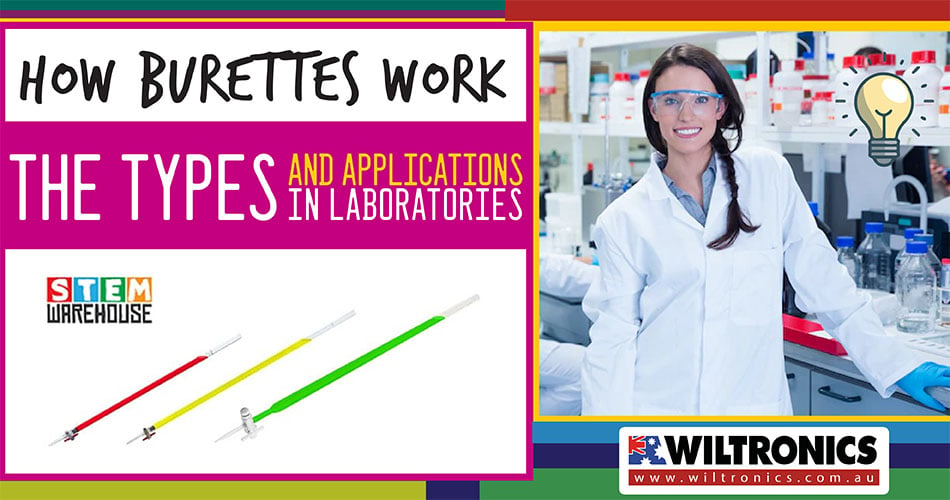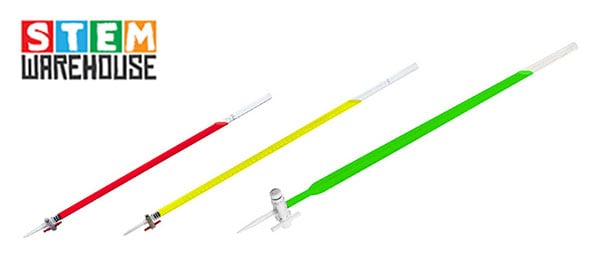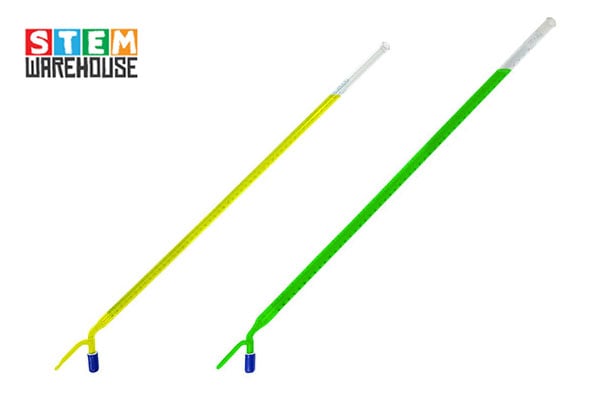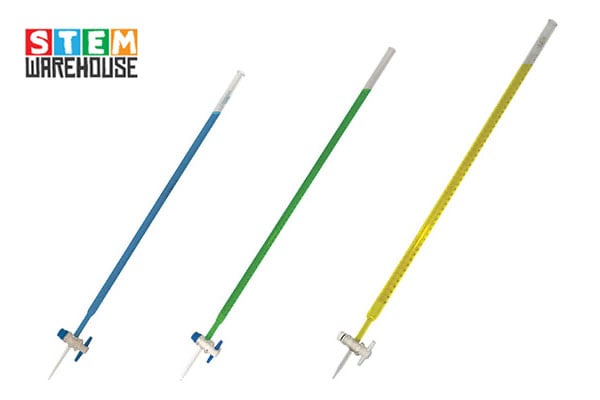How Burettes Work, the Types and Applications in Laboratories
December 27, 2022

Burettes are essential laboratory equipment, but what are they used for?
When it comes to scientific measurements, accuracy manifests ‘accepted, true value’. There is no time for poor data processing and human error, let alone for bad equipment.
To do the job in precise order, lab techs must rely on a reliable apparatus. Take performing a quantitative analysis in a chemistry laboratory, for example. Dispensing and measuring a variable amount of chemical solutions is a common routine.
Cue burettes, which essentially serve the same purpose as a pipette but in a different form. Keep reading to learn what this lab piece is, its working principle, and its applications.
Burettes
If you have performed a quantitative analysis, chances are good that you are familiar with them. The word ‘burette’ has French origins – coined by the chemist Joseph Louis Gay-Lussac.
By appearance, a burette is a graduated glass tube with a stopcock at the bottom. Its uses in lab procedures involve accurate fluid dispensing and titration.
The working principle
Burettes deliver a chemical solution with a known concentration into a flask. The stopcock valve controls the fluid flow from the burette, either in a steady stream or drop by drop. They come in handy when dispensing and measuring liquids (sometimes gas) with accuracy.
For gas burettes, the tube is filled with a fluid (e.g. water, oil, or mercury). The bottom of the tube is attached to a reservoir of the same fluid. The amount of displaced fluid measures gas.
Also spelled buret, a burette is often used in the titration process.
Titration
Titration is a method that uses a solution of a known concentration called titrant. It analyses and determines the titrant of another solution.
Generally, the known solution or titrant is added from a burette to the unknown solution, a.k.a. analyte, until the reaction is complete. An analyte is usually an acid in acid-base titration.
Then, an indicator signals the end of the reaction, the endpoint. The endpoint is the point at which there is complete neutralisation of eth acid with the base. The colour change determines this.
Types of Burettes
There are three types of burettes, and these are:
- Volumetric
- Digital
- Electronic
Volumetric burette
A volumetric burette comes with a volume scale printed on the burette wall, hence the name. A stopcock is found at the end of the instrument, plus a valve to control the liquid flow.
It can be made of glass or plastic material and be classified as: a liquid or gas burette. Liquid burettes feature a long graduated glass tube with a stopcock. Gravity causes the fluid to flow when the valve is opened.
Gas burettes, in contrast, have the same stopcock, except that it is at the upper side of the burette. The tube is filled with fluid, such as water or mercury, and is attached to a reservoir at the bottom. The displacement of the fluid collects the gas.
Such burettes are usually fixed with a clamp in an iron stand.
Digital
A digital burette uses a high-precision syringe featuring a barrel and plunger. It is often used as an advanced alternative to the manual burette for conducting titrations.
The barrel has a fixed position, while the plunger is moved by rotating the wheel by hand. The volume is shown on a digital display, eliminating reading errors. This design helps ensure accuracy for any lab applications involving solution measurement.
Electronic
An E-burette features an electronic display, control panel and motor-controlled piston movements. All these components eliminate the need for the manual dispensing of a digital burette.
Its accuracy is also higher due to its motor controlled dispensing. This help avoids human errors in the titration or dispensing process. Even more precise and accurate titrations are achieved.
The Components of Burettes
The components depend on the type of burette you have. A standard unit usually consists of a graduated glass tube and a stopcock at one end. This is the case for volumetric burettes, but with the addition of a tip for dispensing liquid.
Electronic burettes include more advanced components for high work efficiency, such as:
- Adapter. Can fit in most laboratory reagent bottles. Standard sizes available are 28mm, 32mm, 38mm, 40mm, and 45mm.
- Control panel. Used for automatic refilling, performing a zero reset, and switching the instrument off.
- Delivery tube. Provides the facility to deliver the reagent beyond the reservoir.
- Delivery nozzle. Offer a high degree of flexibility in both horizontal and vertical directions.
- Inspection window. Protects chemicals, such as iodine and potassium, from reactions like light. An ember-coloured window is ideal.
- Middle housing. Consists of a piston mechanism inside the burette.
- Recirculation valve. Prevents the loss of reagents during purging.
- Stylus. A sleek pen-like device used to operate the control panel and TFT screen with ease.
- Telescopic tube. Used to draw up the liquid from the reagent bottle to the e-burette and is adjustable.
- TFT screen. Guides quick and accurate titrations and displays numeric data up to the second decimal.
Digital units may be different from e-burettes, but they mostly have the same components. This includes adapters, delivery tubes, inspection windows, recirculation valves and telescopic tubes.
There is also a hand wheel that allows you to set the dispensed liquid by rotating it clockwise or vice versa. ON/OFF buttons, including CLEAR/Selection and Pause, are also available on the upper housing.
The Uses of Burettes
Burettes are widely used in lab settings for quantitative analysis and titration. But they can also be used in other industrial applications, such as:
- In pharmaceuticals for verification of concentration in medicines
- Food industry for testing the acidity levels of food liquids
- In cosmetics, to verify the concentration of ingredients in a safe amount
- Meteorology for measuring the number of air gases
- In bio-fuel manufacturing for impurities measurement in bio-fuel
- Medical diagnosis for analysing body fluids like blood and urine
How to Use a Burette
Now that you know the basics and uses of the burette, here are the best practices for using one. Follow the instructions below for titration.
Step 1: Rinsing
Rinse the burette with water and let it drain through the stopcock into a waste container.
Step 2: Support
Place the burette in appropriate support by using a burette clamp attached to a ring stand.
Step 3: Filling
Fill the burette with the titrating solution to be used just above the zero mark (+/- 10mm) and the tip with the solution. If necessary, place the funnel on the upper end of the nozzle to help fill.
Step 4: Remove air bubbles
Air bubbles should not be in the tube after filling the liquid. If there are any, use rubber or any soft item to tap the wall and let the bubbles float out of the surface.
If air is present in the channel of the stopcock switch, twist the plug to discharge.
Step 5: Initial reading
Ensure that the burette is well sealed. The reading must also be made tangent to the lower part of the meniscus. Keep your eyes on this level to avoid parallax errors.
Step 6: Dripping
Open the stopcock and slowly let the liquid drain into the receiving vessel. Wait until it approaches the end point.
Step 7: Endpoint
You may add the titration solution quickly, a few millimetres less than the endpoint. Make sure to determine the endpoint accurately when adding the solution. Close the stopcock once the right amount of liquid has been delivered. Remove any partial drops to the side of the vessel.
Step 8: Final reading
Read the volume of the remaining liquid.
Step 9: Calculation
Calculate the reading by subtracting the Final Reading from the Initial Reading.
Step 10: Drain
Drain the burette of any excess liquid and rinse it with water to clean it.
Get Your Burettes Here!

Acrylic Burettes with Teflon Stopcock
Ideal for dispensing variable, measured amounts of a chemical solution. The Teflon stopcock does not need any greasing, thanks to its self-lubricating nature.

Glass Burette with Teflon Rotaflow Stopcock
Made of glass and features a Teflon rotaflow stopcock. Tested for high-accuracy valve delivery.

Graduated Glass Burette with Teflon Stopcock
A graduated glass burette with a Teflon stopcock to prevent jamming when using acids. Available in 25ml, 50ml and 100ml in size.
The Bottom Line
When working with a burette, always keep caution in mind. Be careful with the chemicals and adopt proper disposal methods after the experiment. For extra precision, a digital or electronic burette is your best bet.
© Electrotech Brands Pty Ltd 2022


Write a Comment
You must be logged in to post a comment.